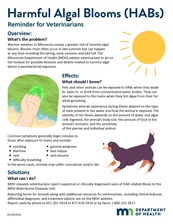Keep reading...

Harmful algal blooms
The following is a message from our friends at the Minnesota Department of Health.
Warmer weather in Minnesota means a greater risk of harmful algal blooms. Blooms most often occur in late summer but can happen at any time including the spring, early summer, and late fall. The Minnesota Department of Health (MDH) advises veterinarians to be on the lookout for possible illnesses and deaths related to harmful algal bloom (cyanobacteria) exposure.
What should I know?
Pets and other animals can be exposed to HABs when they wade in, swim in, or drink from contaminated waterbodies. They can also be exposed to the toxins when they lick algae from their fur while grooming.
Symptoms animals experience during illness depend on the type of toxin present in the water and how the animal is exposed. The severity of the illness depends on the amount of water and algal cells ingested, the animal’s body size, the amount of food in the animal’s stomach, and the sensitivity of the species and individual animal.
Common symptoms generally begin minutes to hours after exposure to toxins and include:
- Vomiting
- Diarrhea
- Rash
- Difficulty breathing
- General weakness
- Liver failure
- Seizures
In the worst cases, animals may suffer convulsions and/or die. MDH requests veterinarians report suspected or clinically diagnosed cases of HAB-related illness to the MDH Waterborne Diseases Unit.
Reporting forms for animals along with additional resources for veterinarians, including clinical features, differential diagnoses, and treatment options are on the MDH website.
Report cases by phone to 651-201-5414 or 877-676-5414 or by fax to 1-800-233-1817.
|
Latest on H5N1 in dairy
Here are the latest documents we've released on the H5N1 in dairy in Minnesota:
Website changes
Migrating sounded so cool, we thought we'd give it a try. The Board of Animal Health website might look a little different because we just migrated our webpage onto a new platform. Aside from major tweaks in the background most users won't notice, we have a few places you might spot differences like our online forms and some of the site navigation. We hope these improvements make the user experience better for everyone using our site.
Premises Identification Numbers (PINs)
Each livestock premises in Minnesota is entitled to request their own PIN. Because this information is tied to an individual, it is considered private or nonpublic data and we aren't allowed to release it publicly. Veterinarians often complete paperwork for clients and call our office to request the client's PIN, which we aren't allowed to release. The veterinarian has to get that information from the producer.
Producers can request their PIN on our website.
|